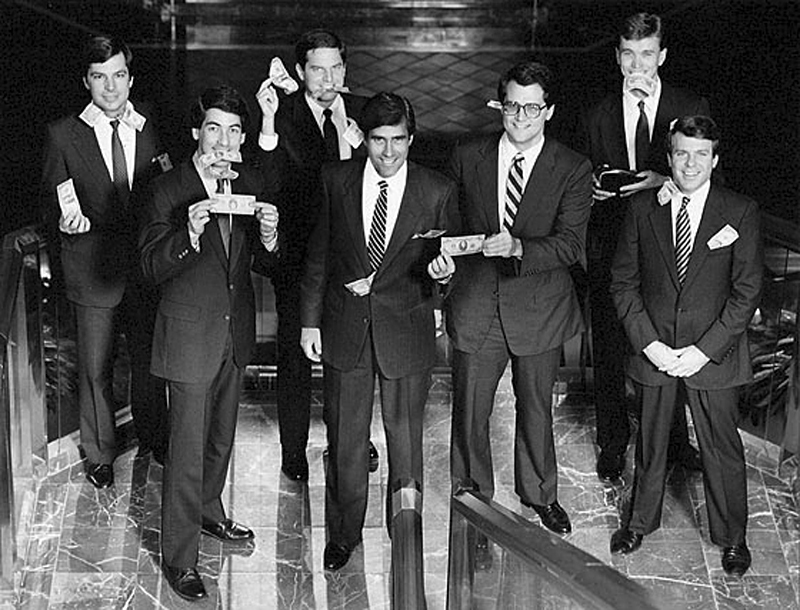By the time the 2009 football season rolled around, the University of Minnesota hadn’t won a Big 10 title in 42 years. The Gophers largely spent those decades serving as target practice for the conference’s higher powers, yet they weren’t without occasional bursts of second-string glory. One arrived two years ago. Minnesota finished 6-6, achieving the minimum wins needed to earn a slot in the Insight Bowl in Tempe, Arizona.
Their bragging rights would be slender. Every year, 70 of the Division I Football Bowl Subdivision’s 120 teams get bowl invitations, making faceless games like the Insight akin to summer-camp participation awards.
Minnesota would face Iowa State, another 6-6 team from the Big 12. The teams were charged with providing three hours of TV programming for hard-core fans and shut-ins just before New Year’s. The ratings would be measured in decimal points.
But within the U of M football offices in Minneapolis, there was cause for celebration, however muted. Though the game orbited well outside the realm of consequence, it was still a chance to reward players, boast to recruits, liquor up boosters, and feed a small army of university suits with a paid vacation in the Arizona sun.
The accounting office no doubt held a much different view. It surely knew that, like nearly all bowls, the Insight was designed to plunder all it could from a college treasury.
The bloodbath began the moment the contract was signed. Minnesota was obligated to write a check for 10,000 tickets, which were supposed to be resold to fans. Never mind that even the best of teams struggle to unload such amounts. For middling squads like the Gophers, it was nothing more than a way for the men in funny yellow blazers who ran the Insight to grab piles of money from a public university.
Minnesota managed to sell just 901 seats. After kicking another 900 to the band, administrators, and cherished hangers-on, the school was forced to eat $476,000 worth of useless tickets.
The contract also required the team to show up a week early, if only to burn as much school money as possible at the restaurants and retailers of Greater Phoenix.
One would think school administrators would protest such gall. But one would be wrong. They were quick to see the advantages of a luxury vacation on the school’s dime. So they happily signed off. The school’s traveling party was larded up with 722 people, including players, band members, and faculty. Airfare alone ran $542,000. Toss in hotels and meals, and the school had blown $1.3 million before the opening kickoff.
The ballsiest part of all: None of it was necessary.
Minnesota and Iowa State sit less than 200 miles apart. Their teams were providing the game. Their bands supplied the halftime entertainment. In fact, the Insight offered nothing—save for warm weather—that the schools couldn’t have done better themselves. Had the game been played in Minneapolis, the teams could have sold more tickets and put on a profitable game, since Big 10 matches typically generate $1 to $2 million, not knee-bending losses.
Yet none of this was ever considered. Thanks to an alliance of unblushing incompetence and corruption, college football long ago decided to outsource its most valuable asset—its postseason earnings.
The scheme plays out each year on the ostensibly pristine fields of amateur athletics. Bowl executives grant themselves breathtaking salaries. The games, meanwhile, provide coaches, athletic directors, and the suits who nominally supervise them with an unending stream of bonuses.
Everyone else picks up the tab.
There’s a reason cities hosting Super Bowls or rounds of March Madness bid with buffets of giveaways just to land the tourist traffic: If you want a taste, you have to pay.
College football is the only sport that gives away its postseason revenues. Its business model is akin to Walmart keeping its profits for the first 10 months of the year, then letting Value World host its holiday sales.
This is an especially hazardous form of capitalism for the nation’s universities, which have been bloodied by ever-diving state funding combined with double-digit tuition hikes. And contrary to popular belief, their athletic departments just widen the damage. Depending upon the year, only about 10 of the 120 athletic departments in the Division I Football Bowl Subdivision actually pay for themselves. The rest require students and taxpayers to ride to the rescue.
Minnesota is typical. From 2006 to 2009, the Gophers went to three Insight Bowls. Their bill for unsold tickets alone was well over $1 million. At the same time, their athletic department needed a $25 million infusion over five years just to break even.
These kinds of losses could be allayed if college football simply cut out the middlemen—the bowls—and took its postseason in-house by adopting a playoff system. Instead, universities have chosen to hand their money away in a deal that’s at best moronic, and at worst an epic swindle.
The racket works like this: Through required purchases of anywhere from 10,000 to 17,500 tickets, schools essentially pay for the right to appear in a bowl. The bowls keep the ticket and sponsorship money. Bowl execs also negotiate their own TV contracts.
After taking 50 to 60 percent off the top, the bowls then write checks to the teams’ conferences. The conferences, in turn, split that money among their schools. (Profits from the five Bowl Championship Series games are spread in varying degrees among all conferences.) But only about half of the 35 bowls offer payouts large enough to cover team expenses. So the conferences use money from more lucrative bowl games to cover losses from the barkers.
“You don’t lose money going to bowl games, at least not in the Big 10,” says Minnesota football spokesman Andy Seeley. But that’s true only in a technical sense. In the Gophers’ case, the Big 10 covered the university’s $1.3 million blemish from the 2009 Insight Bowl. What insiders don’t mention is the humongous pyramid of cash schools are leaving on the table.
“They should go take Economics 101,” says Dan Wetzel, a Yahoo sports columnist and co-author of Death to the BCS. “Lost profit is lost money to any other business in the world.”
And these losses are staggering. Last year, the nation’s bowls paid schools roughly $270 million. Just for playing middlemen and providing 70-degree temperatures, bowl execs grabbed a larger cut, north of $300 million.
Even bowl apologists admit that by implementing a playoff system—as every other NCAA sport does—schools could generate three to four times what they’re bringing home now. That’s because TV networks will pay far more for a playoff game than they will for straight-to-DVD thrillers like the Beef O’Brady’s St. Petersburg Bowl.
Under a playoff system, the schools’ collective take might even approach $1 billion annually. It’s the kind of money that could fill budget gaps in nearly every Division I FBS school’s athletic department. Yet one small barrier stands in the way: A playoff system would ensure that schools would take home the money, not the insiders who make these decisions.
So college football is left with lopsided accords like Minnesota’s. While the Gophers were requiring a Big 10 bailout for those large red numbers in Tempe, Insight CEO John Junker was paying himself nearly $600,000 a year, with added perks like country-club memberships as far away as Oregon and Oklahoma.
Coaches and athletic directors make a similar killing. Three years ago, the University of Florida beat Oklahoma for the national title. The Gators may have generated untold riches, but the school itself managed just a $50,000 profit—enough to pay for a team banquet and perhaps another part-timer for the groundskeeping crew.
Florida’s coaches and athletic officials were bound by no similar restraints. They took home $960,000 in bonuses.
That’s the beauty of the system: No matter how much money is torched, the insiders always get paid.
“The money is not the reason we have the system we have,” says Bill Hancock, executive director of the Bowl Championship Series, or BCS. “It rewards the athletes at the end of the year with a celebration.”
It’s a common refrain among the sport’s elder statesmen, and the gentlemanly Hancock speaks with the earnestness of a true believer. There’s little doubt players have earned a respite after the ceaseless beatdown that is a football season. Especially since they receive but a fraction of the towering wealth they generate.
Minnesota’s Seeley describes bowls as an educational experience, a chance for young men to spend a week learning about another part of the country. But considering that schools are giving away more than $300 million a year to bowls, it may be the most expensive week of touring amusement parks and children’s hospitals ever conceived. And it presumes the schools couldn’t do it better without making someone else rich.
Take Junker, the system’s most egregious sponge. He was the CEO of the Insight and Fiesta bowls until he was fired last spring. His games may technically have been charities; he just considered himself the neediest recipient of all.
According to lawyers hired by the bowls’ board to investigate malfeasance, he blew $33,000 on his own birthday party in Pebble Beach. He spent $19,000 on country-club memberships in three different states. When he wasn’t running up $1,200 bills at strip joints, he was bidding $90,000 in a charity auction to play golf with Jack Nicklaus.
It all came from money that could have gone to America’s colleges. More alarming, Junker’s spree only ended after he was outed by The Arizona Republic for illegally reimbursing employees for donations to his political allies.
Most bowl executives have equally inflated views of their own value. Orange Bowl CEO Eric Poms pays himself $506,000 a year, and kicks nearly $1 million more in salaries to four lesser execs. Outback Bowl President Jim McVay takes in $808,000 annually. The bosses for the Cotton and Alamo bowls make $419,000. For staging one game a year. Meanwhile, the nation’s colleges put on 10 times the number of events back home at just a fraction of the cost.
Bowl executives defend themselves by claiming to run charities. That may be true in terms of their IRS status, but charity implies giving to someone other than yourself. In the world of college bowl games, that hasn’t happened for more than 60 years.
Studies show that as far back as 1947, bowls were giving less than 1 percent of their receipts to the needy. Today, their benevolence ranges from just 1 to 3 percent. By comparison, “Most highly efficient charities will spend 75 percent or more,” says Megan Davison of CharityWatch, a Chicago group that helps donors find the most effective charities. “A program that spends 60 percent will get a C grade from us.”
So what does one receive for donating just 3 percent? “We would give them an F grade and call them pathetic and urge the general public not to support them,” says Daniel Borochoff, president of CharityWatch.
But while bowls violate every principle of philanthropy, state and city politicians are happy to look away. The games’ nonprofit status may allow them to skirt taxes, but they do deliver built-in tourist traffic.
To ensure no one asks too many questions, the bowls fete these same politicians with receptions, comped tickets, and sideline passes. The Fiesta Bowl even paid for luxury legislator junkets to cities like Chicago and Boston.
The bowls do their best to cloak this strange approach to philanthropy. Both the Orange and Sugar bowls claim they do wonders for their cities’ charities; for reasons unexplained, they just don’t include those donations on their books. Meanwhile, bowls like the Cotton simply ignore a reporter’s requests for comment.
Even the small number of bowls set up as for-profit enterprises claim to be charitable in spirit. At Houston’s Meineke Car Care Bowl, one of seven games owned by ESPN, spokesman Zac Emmons is happy to note that $400,000 has been donated to the DePelchin Children’s Center over the past five years. But he isn’t authorized to reveal what percentage of the game’s revenue went to charity—or how much executive director Heather Houston is paid.
ESPN network publicist Rachel Margolis won’t talk numbers either: “We usually don’t disclose any information related to revenue or wages for any of our bowls,” she says.
Equally trapped in an altruistic mirage is the Kraft Fight Hunger Bowl in San Francisco, sponsored by food giant Kraft. The bowl insinuates that it’s part of Kraft’s marketing campaign to give away 25 million meals a year. Spokesman Doug Kelly claims the bowl “donated the equivalent of 120,000 meals” in 2010. That’s likely an overstatement. The game’s own website says it gives away just one meal per ticket sold, and the Kraft is known for hosting pastures of empty seats. So it’s not surprising that Kelly gets defensive when asked what percentage of the revenue goes to the hungry. “That’s proprietary,” he responds.
He’s politely informed that, as a charity, the bowl is obligated to make such figures public. After all, Sports Business Journal reports that the game’s CEO, Gary Cavalli, makes $377,475 a year, likely making him the hungriest of all. But Kelly is in no mood to provide details of the game’s supposed largesse. He suddenly claims that he’s been speaking off the record and that he can’t be quoted.
The BCS’s Hancock wisely downplays the beneficence angle, well aware that it’s riddled with blather. Instead, he emphasizes the tourism advantages to host cities. He’s right, of course. By forcing schools to write mammoth ticket checks—and contractually coercing teams to stay longer than they need to—bowls do wonders for warm-weather economies.
“There’s no question bowl games benefit charities in their community,” Hancock says. “From my perspective, the economic development to the community is significant. It’s a blend. I think the people who talk about the bowls as nonprofits exclude the economic-development end.”
Left unmentioned is why Washington state residents will be thrilled to see their tax money burned in San Antonio when the Huskies face Baylor in this year’s Alamo Bowl. Or why University of Missouri students would have wanted to subsidize Tempe when the Tigers played the Insight last year. That’s the problem with the insiders: The system rewards them so lavishly, they simply can’t fathom that others might resent paying the freight.
College presidents could easily put a stop to the shell game. If they had the will. Which they don’t.
They tend to be a lot like coaches, a job-jumping species forever on the hunt for more prestigious posts. This march to greater altitudes requires staying in the good graces of trustees and big donors, who enjoy free bowl vacations as much as everyone else. Besides, many presidents wield less institutional power than their own coaches, as Penn State’s pedophilia scandal revealed. So they behave like congressmen, allowing their schools to be pillaged to preserve their political capital. Better to kick these decisions to athletic directors and conference commissioners.
And that’s where the pitfalls begin.
“The bowl directors are a lot smarter than the athletic directors, because anyone who would agree to this deal is getting whomped,” says Yahoo columnist Wetzel.
It’s not that ADs are necessarily stupid. Let’s just say they’re incurious and not especially self-aware.
Most have spent years, if not decades, being chummy with bowl execs. When they’re invited to events like the Fiesta Frolic, a weekend of splendor and golf in Phoenix—price tag: $387,421—they don’t believe their allegiance is being purchased. It’s just a swell time among old friends.
The same goes for the Orange Bowl’s Summer Splash events. Last year’s featured an “all-inclusive, three-night, four-day complimentary getaway” for 40 insiders and their guests, according to the invitation. They sailed the Caribbean, docked at a private island, and spent their days parasailing and “sipping delicious Coco Locos on a hammock.” Don’t forget the free pedicures.
“It’s really an opportunity for us to bring key stakeholders together, whether conference people or folks from the schools, to come down to South Florida and to get a taste of what we have to offer,” says Orange Bowl vice president Larry Wahl.
Yet he admits his game, part of the BCS series, has to “vie constantly to maintain the position in the BCS. It comes up for renewal every four years.” And nothing ensures that renewal like a free luxury cruise.
Wetzel contends that athletic directors simply aren’t bright enough to know they’ve been bought, seeing these freebies from friends as just another part of college football’s grand tradition. So they’re not inclined to get too inquisitive over contracts. And this allows their “friends” to utterly rip them off.
The biggest scam is the bulk ticket purchases. Depending upon the bowl, schools are required to buy anywhere from 10,000 to 17,500 up front. So begins the seasonal hemorrhage.
The deal starts with a presumption of failure. Even powerhouses like Ohio State rarely sell that many. When the Buckeyes played in the Fiesta Bowl in 2009, they failed to sell more than 7,000 seats. Price for this bath: $1 million. Auburn, last year’s national champion, was still stuck with $781,000 in unsold tickets from the title game.
What’s worse is that the seats depreciate from the moment of purchase. Though attendance for most games is a fraction of capacity, the schools still pay bloated face-value prices. Their “friends” aren’t about to grant them bulk discounts. So when the colleges can’t sell these seats to their fans, the market is flooded with more than 200,000 bowl tickets a year.
Prudent UCLA fans, for example, know better than to buy heftily priced seats from the school. After all, a ticket broker will soon be pushing the same seats for dimes on the dollar. StubHub once famously sold tickets to the Music City Bowl in Nashville for just 19 cents.
So though Connecticut may have won the Big East championship last year, it still failed to sell 14,729 seats to the Fiesta Bowl. The bowl charged the Huskies prices ranging from $111 to $268 a ticket. StubHub, meanwhile, was offering them at $20 a pop.
The ticket scheme alone leaves schools awash in red ink. Virginia Tech lost $400,000 on last year’s trip to the Orange Bowl—despite getting $1.2 million from the ACC. Though Auburn claimed last season’s BCS crown, financial records show it still lost $600,000—even after a $2.2 million bailout from the Southeastern Conference.
Some bowls have also found a way to scam schools on hotels. Since the bowls usually arrange lodging, athletic directors assume their “friends” are negotiating the best group deals. But that’s not always the case.
Under Junker’s rule, the Fiesta Bowl required schools to purchase 3,750 room-nights at about $200 a pop. According to the contract, the schools had to pay whether they used them or not.
But what Junker wasn’t telling his “friends” was that he’d arranged a side deal with the Scottsdale Convention & Visitors Bureau. In exchange for funneling teams to Scottsdale resorts, the city’s tourism arm agreed to kick the Fiesta Bowl $8.2 million over the 20-year pact, according to a contract discovered by The Arizona Republic. The Sugar Bowl also received “voluntary commissions” from New Orleans hotels. Other bowls have been accused of similar arrangements.
It’s nothing more than a massive “money-laundering” scheme, says Richard Southall, director of the College Sport Research Institute at the University of North Carolina. That’s the only way to describe a system where schools send millions to bowls, then bowls use a fraction of that same money to pay teams for playing.
The problem for college football is that too many people are taking notice.
Consider Taylor Morgan. He’s a board member of Playoff PAC, a fan group launched to protest the way the BCS picks title contenders. It’s a ubiquitous complaint. One Gallup poll showed that 85 percent of fans favor a playoff system, leaving bowls slightly more popular than polio.
But Morgan and his friends soon realized the selection process was a minor travesty. More galling was the way bowls grabbed money from everyone in their path. “These bowls receive millions of dollars in federal and state subsidies,” says Morgan. “They don’t donate money to their communities. They don’t do anything of substance in a charitable sense, other than line the pockets of their friends and executives.”
So Playoff PAC posted financial records from bowls and schools for everyone to see. It also began bombing the IRS with complaints that bowls were violating their charitable tax status. Add books like Wetzel’s Death to the BCS, a step-by-step account of this wholesale soaking, and bowl execs were suddenly being publicly strafed for their sins. Just a few years ago, these same execs were claiming before Congress that they were legitimate charities. These days, they’re being confronted with their own financial reports that say otherwise.
The system’s also facing attack on the antitrust front. Only the six biggest conferences—plus the Notre Dame athletic director—have voting rights within the BCS. The BCS picks the teams for the top five bowls. These six leagues also receive the largest revenue cuts, leaving the five remaining Division I FBS conferences at their mercy.
Sports economist Andrew Zimbalist likens it to Major League Baseball allowing the Yankees, Red Sox, and Phillies to decide who makes the playoffs—and guaranteeing themselves the biggest paydays. So he and 21 other economists filed a complaint last spring urging the Justice Department to investigate the BCS for antitrust violations.
Despite its access to the country’s best mathematicians, many argue, the BCS can’t even get its computer rankings right. Famed sports statistician Bill James has said they’re based on “nonsense math.” Hal Stern, a professor at the University of California-Irvine, has even called for a BCS boycott in the Journal of Quantitative Analysis in Sports.
Then there are the university presidents. Faced with continuous funding cuts, at some point they’re bound to go looking for new revenue. Since March Madness generates more than $600 million a year, schools might belatedly realize that a playoff for football, the more popular sport, is sure to bring a torrent of cash. Fortunately, even those short on courage tend to find it when free money’s in sight.
Hancock seems to know the end is near, though he won’t say it outright. The BCS contract expires in 2014, and Hancock acknowledges that dozens of new proposals are floating around college football.
History says the insiders will try to change as little as possible. They’ve offered minor concessions every few years since the dawn of the BCS, just enough to keep attorneys general and nosy congressmen at bay. But the bowls’ duplicity is so obvious they can’t hold on much longer.
“I want what’s best for the students,” Hancock says. If he’s being honest with himself, he can’t help but push for reform. After all, he has to know that at the bottom of this insiders’ pyramid are those who can afford it least—the kids paying tuition.
“What’s really egregious is they shift that burden to their students,” says Morgan.
And that’s the unholiest part of it all.
With reporting from Tim Elfrink.








